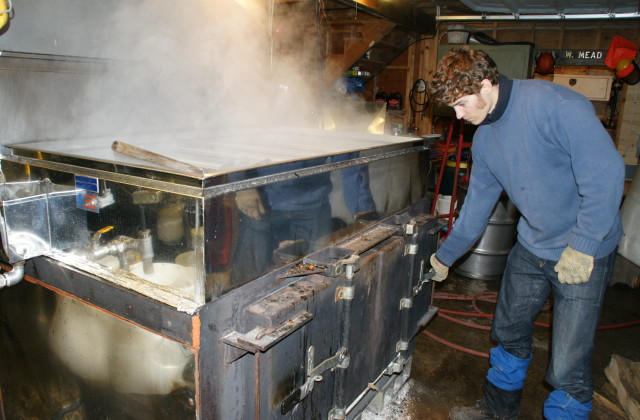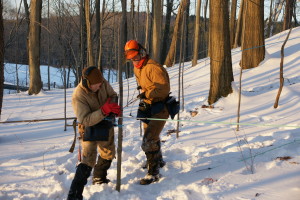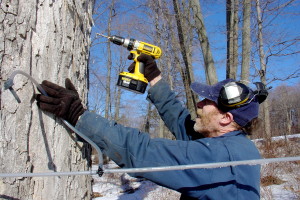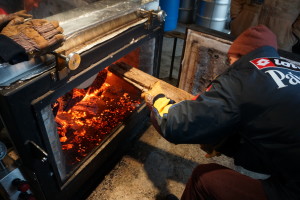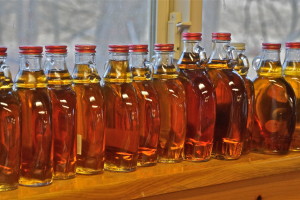News From the Sugarbush
Family Maple Syrup Operation Gears Up for Unpredictable Season
By Jude Mead
It is maple syrup season again, and people always ask what type of year we are expecting. They believe that a heavy snowfall in winter must mean lots of maple sap in the trees, while a dry winter means less sap. But for as long as I have been producing maple syrup with my family, I have not found snow a predictor of the syrup season. The weather pattern sugarmakers do depend on, however, is the springtime alternation of freezing nights and warmer, 40-degree days, a cycle that helps to build up pressure in the trees, causing the sweet sap to flow. Needless to say, my family and I listen and watch the weather closely during syrup season.
As we watch for the signs of “sugaring weather,” there is much to do before the sap starts running. Maple syrup equipment has evolved since the days of aluminum buckets and open evaporators, but even with a more sophisticated system, it is still hard work. Today, instead of buckets that hang on trees to catch the sap, we have miles of tubing lines to stretch and check. The colorful lines zigzag through the sugarbush in a dizzying fashion that challenges our brain to keep them in order. We then drill holes in the trees, tap in the stainless steel spouts, and attach the lines. This is an arduous task but the lines’ efficiency is worth the labor, although we still contend with squirrels and bears that love to bite into the tubing for the sweet sap.The lines then carry the sap either by gravity or a vacuum system to the sugarhouse, where it is filtered through a reverse-osmosis machine. This machine separates most of the water from the sap and leaves the sugar solids. It is effective and reduces boiling time, lowering the sap-to-syrup ratio from 40-to-one to about 11-to-one. Gone are the days of boiling for 8–10-hour shifts and cranky maple syrup producers.
Once the sap’s water content has been reduced, it goes to the evaporator. The evaporation process is my favorite part of making maple syrup, except for eating it of course. There is no experience that compares to inhaling the sweet, maple-scented steam that billows from the sugarhouse. As the water evaporates and the sap thickens, hundreds of golden bubbles form in the front pan. This signals that the syrup has reached 219 degrees and is ready to be drawn off. In the early days we tested by thermometer for temperature and hydrometer for density. Then we would open the spout by hand and wait. But technology has its pluses, and today all that is done automatically for us.This is still not the finished product though, because it has to be filtered, adjusted for density and graded for flavor and color. While all maple syrup is of equal quality, sugar content and thickness, preferences about grade are a matter of personal taste.
Recently, the International Maple Syrup Association changed the grading system. Consumers today prefer the darker syrup, formerly known as Grade B, a designation that conveyed inferiority. I do not know how many times I had to explain that maple syrup is graded by color and taste, not by quality.Today all syrups fall within Grade A, but with a descriptive term added. The old grading system meant little to the consumer. What does Grade A Amber mean? What does Grade A Dark taste like?
Adding a description to the grade is helpful. Think of it as the way coffee is described. The new grades are now Grade A Golden, Delicate taste; Grade A Amber, Rich taste; and Grade A Dark, Robust taste (this is the old Grade A Amber and Grade B combined). The commercial or cooking grade syrup (usually the last syrup processed in the season) is called Grade A Very Dark, Strong taste.
The new names and the unified grading system make it easier to market syrup, both domestically and internationally.But although things change in the industry, the love for producing delicious, pure maple syrup has remained the same. When we first started over thirty years ago, I believed there should have been some type of warning label issued for the beginner, such as “Beware: Sugaring may be addictive.” Once maple syrup does its magic, there is no turning back.
All photos by Jude Mead.
